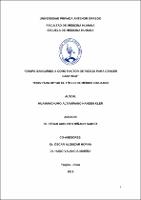| dc.contributor.advisor | Miñano García, César Augusto | |
| dc.contributor.author | Huamanchumo Altamirano, Hansen Kler | |
| dc.creator | Huamanchumo Altamirano, Hansen Kler | |
| dc.date.accessioned | 2018-09-07T21:40:21Z | |
| dc.date.available | 2018-09-07T21:40:21Z | |
| dc.date.issued | 2018 | |
| dc.identifier.uri | https://hdl.handle.net/20.500.12759/4285 | |
| dc.description.abstract | OBJETIVO: Determinar si el grupo sanguíneo A es un factor de riesgo para
cáncer gástrico en un estudio multicéntrico.
MATERIAL Y MÉTODO: Diseño de casos y controles multicéntrico en hospitales
de la ciudad de Trujillo durante el período entre el 2012 y 2016. La muestra se
dividió en 405 casos con cáncer gástrico y 418 controles.
RESULTADOS: El promedio de edad fue 63.5±15.6 y 54.01±18.5 para casos y
controles respectivamente, con diferencia estadística altamente significativa
(p>0.01). En el análisis bivariado el grupo sanguíneo A mostró diferencia
altamente significativa (p<0.01), estando presente en el 56.5% de casos y 13.4%
de los controles. En el análisis multivariado, el grupo A confirmó su asociación
con diferencia altamente significativa (p<0.01; OR 8,768 IC 95% [6,080-12,646]).
Dentro de las características generales el Helicobacter pylori tuvo asociación con
diferencia altamente significativa, así como edad y procedencia (p<0.01).
CONCLUSIONES: El grupo sanguíneo A fue un factor de riesgo para cáncer
gástrico. Se sugiere comunicar a la comunidad médica el resultado obtenido y
son aconsejables estudios prospectivos, con semejanza en los grupos etáreos. | es_PE |
| dc.description.abstract | OBJECTIVE: To determine if blood group A is a risk factor for gastric cancer in
a multicenter study.
MATERIAL AND METHOD: Multicenter case-control design in hospitals in the
city of Trujillo during the period between 2012 and 2016. The sample was divided
into 405 cases with gastric cancer and 418 controls.
RESULTS: The mean age was 63.5 ± 15.6 and 54.01 ± 18.5 for cases and
controls respectively, with a highly significant statistical difference (p> 0.01). In
the bivariate analysis blood group A showed a highly significant difference (p
<0.01), being present in 56.5% of cases and 13.4% of controls. In the multivariate
analysis, group A confirmed its association with a highly significant difference
(p<0.01; OR 8,768 IC 95% [6,080-12,646]). Within the general characteristics,
Helicobacter pylori was associated with a highly significant difference (p <0.01),
as well as age and origin(p <0.05).
CONCLUSIONS: Blood group A was a risk factor for gastric cancer. It is
suggested to communicate the obtained result to the medical community and
prospective studies are advisable, with similarity in the age groups. | en_US |
| dc.description.uri | Tesis | es_PE |
| dc.format | application/pdf | es_PE |
| dc.language.iso | spa | es_PE |
| dc.publisher | Universidad Privada Antenor Orrego - UPAO | es_PE |
| dc.relation.ispartofseries | T_MED.HUMA_2417 | |
| dc.rights | info:eu-repo/semantics/openAccess | es_PE |
| dc.source | Universidad Privada Antenor Orrego | es_PE |
| dc.source | Repositorio Institucional - UPAO | es_PE |
| dc.subject | Sistema del Grupo Sanguíneo ABO | es_PE |
| dc.subject | Neoplasias Gástricas | es_PE |
| dc.title | Grupo sanguíneo A como factor de riesgo para cáncer gástrico | es_PE |
| dc.type | info:eu-repo/semantics/bachelorThesis | es_PE |
| thesis.degree.level | Título Profesional | es_PE |
| thesis.degree.grantor | Universidad Privada Antenor Orrego. Facultad de Medicina Humana | es_PE |
| thesis.degree.name | Médico Cirujano | es_PE |
| thesis.degree.discipline | Medicina Humana | es_PE |

